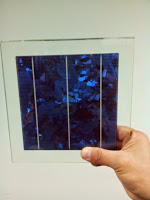Green Energy
 Solar cell is an electrical device which converts the light energy directly into electricity utilizing photovoltaic effect. It is also defined as the form of photoelectric cell having electrical characteristics like current, voltage and resistance.
Solar cell is an electrical device which converts the light energy directly into electricity utilizing photovoltaic effect. It is also defined as the form of photoelectric cell having electrical characteristics like current, voltage and resistance.
- World Record Trina Panel At Green Energy Wa
The results have been confirmed by TUV Rheinland, with a 156x156mm 60 cell module reaching 274 Watts peak. HAMBURG, Germany Trina Solar Limited (NYSE: TSL) ("Trina Solar" or the "Company"), a leading integrated manufacturer of solar photovoltaic (PV)...
- Xunlight Partners With Trina Solar On Pv System
Toledo, Ohio United States Xunlight Corporation, a manufacturer of flexible and lightweight thin-film silicon solar modules has completed a 220 KW demonstration project utilizing its flexible solar panels, in partnership with Trina Solar. In this project,...
- Researchers Create Efficient, Recyclable Solar Cells From Trees
Researchers from Georgia Institute of Technology‘s Center for Organic Photonics and Electronics (COPE), in collaboration with Purdue University have unveiled a new efficient, recyclable organic solar cell made from trees—or, more specifically, from...
- Organic Solar Cells
Heliatek GmbH announced a record breaking 12% cell efficiency for its organic solar cells, establishing a world record. In cooperation with the University of Ulm and TU Dresden, the solar cells were measured by the accredited testing facility SGS. The...
- Scientists Build The First All-carbon Solar Cell
article published in www.sciencedaily.com, October 31st 2012 Stanford University scientists have built the first solar cell made entirely of carbon, a promising alternative to the expensive materials used in photovoltaic devices today.The results...
Green Energy
How do solar cells work?
 Solar cell is an electrical device which converts the light energy directly into electricity utilizing photovoltaic effect. It is also defined as the form of photoelectric cell having electrical characteristics like current, voltage and resistance.
Solar cell is an electrical device which converts the light energy directly into electricity utilizing photovoltaic effect. It is also defined as the form of photoelectric cell having electrical characteristics like current, voltage and resistance.There are at least two semiconductor layers in solar cells. One layer contains a positive charge and the other layer contains a negative charge. A typical silicon solar cell consists of a thin wafer having phosphorus doped (N-type) ultra thin silicon layer on the top of boron-doped (P-type) thicker silicon layer. When these two materials are connected with each other, a junction is formed which is called P-N junction. As a result, an electrical field is created near the top surface of the cell. When these two layers are connected to an external load, the electrons flow through the circuit generates electricity.
Sunlight consists of small particles of solar energy called photons. When sunlight strikes on the surface of solar cell, many of the photons are reflected and absorbed by the solar cell. Electrons are released from the negative layer of semiconductor material, when enough photons are absorbed by this layer of the solar cell. These electrons naturally move into the positive layer and create a voltage differential.
Under open circuit, no load conditions, a typical silicon solar cell generates about 0.5 – 0.6 volt DC (Direct Current). The output of a solar cell depends on its surface area (size) and efficiency. It is also proportional to the light intensity of the sun striking the surface of the cell. For example, under peak sunlight conditions, a typical commercial solar cell with a surface area of 160 square centimeter will approximately generate peak power of 2 watts. If the intensity of the sunlight is 40 percent of peak, then the cell would generate approximately 0.8 watts. In order to increase the output power, cells are combined in a weather tight package which is called a solar module. In order to create the desired voltage and amperage, these modules (from one to several thousand) are then wired up in series and parallel with each other. It is called a solar array.
The semi conductor material silicon which is primarily used for the manufacturing process of solar cells is naturally available. Due to the natural availability of silicon and the practically unlimited resource in the sun, solar cells are very environmentally friendly. Solar cells burn no fuel and have absolutely no moving parts which makes them virtually maintenance free, silent and clean.
- World Record Trina Panel At Green Energy Wa
The results have been confirmed by TUV Rheinland, with a 156x156mm 60 cell module reaching 274 Watts peak. HAMBURG, Germany Trina Solar Limited (NYSE: TSL) ("Trina Solar" or the "Company"), a leading integrated manufacturer of solar photovoltaic (PV)...
- Xunlight Partners With Trina Solar On Pv System
Toledo, Ohio United States Xunlight Corporation, a manufacturer of flexible and lightweight thin-film silicon solar modules has completed a 220 KW demonstration project utilizing its flexible solar panels, in partnership with Trina Solar. In this project,...
- Researchers Create Efficient, Recyclable Solar Cells From Trees
Researchers from Georgia Institute of Technology‘s Center for Organic Photonics and Electronics (COPE), in collaboration with Purdue University have unveiled a new efficient, recyclable organic solar cell made from trees—or, more specifically, from...
- Organic Solar Cells
Heliatek GmbH announced a record breaking 12% cell efficiency for its organic solar cells, establishing a world record. In cooperation with the University of Ulm and TU Dresden, the solar cells were measured by the accredited testing facility SGS. The...
- Scientists Build The First All-carbon Solar Cell
article published in www.sciencedaily.com, October 31st 2012 Stanford University scientists have built the first solar cell made entirely of carbon, a promising alternative to the expensive materials used in photovoltaic devices today.The results...
